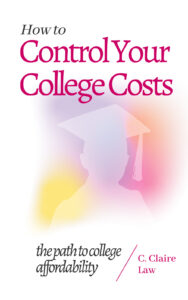Would you like to know how to pay less for college and get a good return on your investment? I’ve watched college prices increase exponentially, over the last thirty years. If I learned anything, it is that families really worry about the whole college “thing” from when their child is born, in elementary, middle, and high school. The national psyche is focused on this preeminent goal. Parents want to make sure their kids will be successful adults, able to support themselves and be happy.
There are 5,300 colleges in the U.S. alone. There are choices. In fact, there are so many choices vying for students’ attention that it’s confusing to know how to compare one college with another. I wonder why there are so many colleges. I suspect it’s because they’re profitable businesses. Colleges employ 2.5% of the U.S. population, contributing $36.9 billion to the US economy. https://agb.org/guardians-campaign/higher-education-contributes-to-a-strong-economy Many small towns rejoice when students return in the fall. I can think of the townsfolks near Hamilton College and Colgate University festooning the town to welcome the students. My son attended Saint Bonaventure University in the little town of Olean (NY) that has grown so much now Saint Bonaventure is a city with its own zip code. Colleges are the lifeline of smaller towns. They are invaluable in this knowledge economy where people need to think critically and many jobs require more than high school graduation.
The unfortunate fact is that higher education has increased way beyond many family’s abilities to pay. Going to college is synonymous with taking out loans. Students and parents can end up with staggering amounts of debt. The cost and amount of debt have to be balanced with the possible return on investment.
You would think that colleges should cost less with the funding they receive from the state, the federal government, donations from alumni, and cash from enrolling students and their parents. In fact, the demographic pool of college-age students is smaller. There were fewer births after the September 11, 2001, terrorist attack on the Twin Towers in New York City. This means more colleges are trying to fill classrooms by chasing after the same student. In addition, the COVID-19 pandemic caused many students to postpone college or enroll locally at their community college. We can expect that the smaller colleges that are tuition-driven may end up closing. As sad as this is, I worry more about parents who invested their resources in a college that was in financial trouble and students who may not graduate in their field of study for lack of enrollment.
Having worked in college admissions and financial aid, I know that colleges and universities have ways to continue and prosper. They employ skilled enrollment managers, financial administrators, admission counselors, and recruiters who together with institutional advancement officers protect the institutional mission. There is an entire machinery behind the scenes working hard to meet the budget each year. Enrollment management is a science that uses regression analysis to predict what amount of financial aid will cause a family in a specific income bracket to enroll their student. I sympathize with the plight of colleges, especially during the COVID-19 pandemic when they had to pivot and reinvent themselves overnight. However, institutional interest is not always the same as student interest.
I’m here to talk about how students and parents can look after their personal interests. They can do so by taking control of the college process. Colleges know how to target the students they want, but families don’t have the same strategies at their fingertips. Teens can be blinded by the prestige of certain name colleges. Not everyone can consult with an Independent Educational Consultant who understands financial aid, and school counselors nationwide carry a load of 350 students on average (https://www.schoolcounselor.org/asca/media/asca/Publications/ratioreport.pdf )
Many students become susceptible to colleges’ recruitment practices. From the time they take their first PSAT they receive mail from colleges all over the state and country. High school students who need lots of financial aid need to be careful. Some are lured by prospects of colleges that promise financial aid. I’ve come across students who with the best of intentions have jeopardized their parents’ financial situation. Middle-class families are not poor enough to get grants, slim pickings though they are, and not rich enough to pay without taking out loans. Even high-income families can end up with hefty tuition bills if their student knocks on the wrong college doors.
Finding a college that meets the students’ academic, social, and cultural needs is super important as is college affordability. Some students have learning disabilities and parents may end up spending more to provide additional academic and social supports. A student’s needs are their needs. They cannot be overlooked. Some parents will have to pay more to place them into colleges where they can grow and thrive.
One mistake I see students make is to look for colleges clear across the country, even before they have taken a look at what’s available in their backyard. Many students need to see the big picture: each state has a major public university, which is the flagship institution, along with many regional campuses. These “satellite” campuses may have strengths in different majors, and often, cost less than the flagship university. In my state of South Carolina, there are 61 institutions of higher learning, including 18 private colleges, and two public and six private historically black colleges and universities. The University of South Carolina in Columbia is the flagship. It has 23,363 undergraduates, an excellent Honors program, and enough majors to satisfy many students’ curiosity. Every state has a flagship university and many public and private universities. Each has its own flavor, strengths, and culture. Typically, students pay less at their in-state public colleges and universities, although many students can find affordable private colleges if they shop wisely.
While private colleges charge the same amount whether students are in-state or out-of-state, tuition at public universities costs two to three times more for students who cross their state-line. I encounter many students who chomp at the bit to at least leave home “go out of state” if not to other parts of the country.
There are reasons for students to study away from home when those colleges offer richer opportunities for growth and development. Some students are worldly and interested in going to college outside the U.S. With careful research, they find some affordable options in the U.K. or Europe. University in Germany and Sweden are free! However, if the cost is a consideration, it is worth calculating the pros and cons. During the COVID-19 pandemic, more students came to appreciate the benefits of attending a college closer to home. As colleges pivoted to online teaching, remote learning became a way of life for many students. It did not make sense to pay for out-of-state tuition when students were sitting at home in front of a screen. The hope is that online education will bring college costs down. Future trends will tell.
It goes without saying that college graduates earn more than those with partial college, high school, or partial high school. A critical factor in determining how much they will earn is the type of major they choose. Of course, choosing a field of study that doesn’t suit them is never a good investment!
If you want to learn more about how personality type can predict which fields of study and colleges students will find more satisfying you may be interested in my book “Find The Perfect College For You” available on Amazon.


